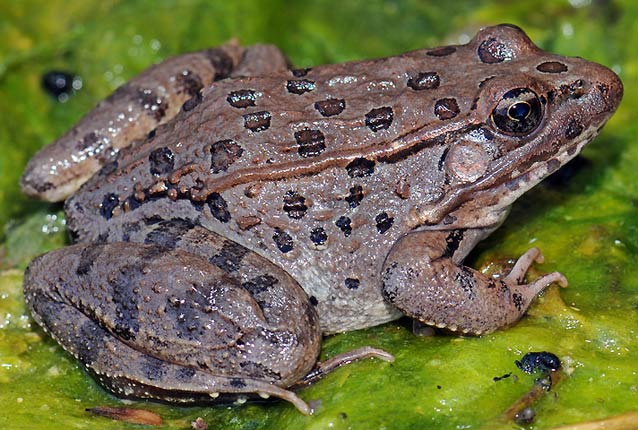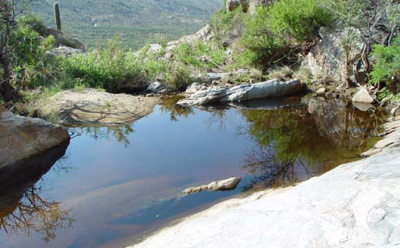Saguaro National Park was established to protect the saguaro cactus, but the park also provides habitat for many unique animals. The lowland leopard frog is a native frog that depends on desert waters. It has declined in the Desert Southwest and is considered a species of special conservation concern.
Park staff conducted a study to evaluate habitat, summarize long-term monitoring data, and make recommendations for conserving lowland leopard frogs (Rana yavapaiensis) and other aquatic wildlife. Saguaro National Park received funds from the National Park Service, Western National Parks Association, T&E, Inc., and Friends of Saguaro National Park, with support from the Desert Southwest Cooperative Ecosystem Studies Unit and U.S. Geological Survey Sonoran Desert Field Station at the University of Arizona.

William R. Radke / USFWS
Methods
We reviewed the natural history and conservation status of the lowland leopard frog throughout its range, including past records in Saguaro National Park. For long-term monitoring, we surveyed eight major canyons at least once annually during 1996–2007, and nine smaller canyons less frequently. In each survey, we visually searched stream pools for all stages of leopard frogs and other aquatic species. For habitat analysis, we studied 24 canyons in the Santa Catalina and Rincon mountains (for details, see Wallace et al. 2008). We compared habitat characteristics among canyons and pools that were either occupied or not occupied by leopard frogs. We also evaluated the effects of fire on leopard frogs in the Rincon and Santa Catalina mountains following the large Helen’s II and Aspen fires of 2003 (for details, see Wallace et al. 2006) by comparing frogs in canyons that had burned with those that did not burn.
Results
Monitoring
During 1996–2007, lowland leopard frogs were observed in approximately 15 canyons in the park’s three major watersheds (Tanque Verde, Rincon-Pantano, and Paige). However, distribution varied greatly among years; for example, during a severe drought in 2004–2006, we found frogs in only five canyons. Frog abundance also varied over time, with the maximum number of adults observed annually ranging from approximately 20 during 1996–97 and 2005–06 to more than 140 during 1999–2000 and 2007. In general, the number of frogs observed decreased during drought years and increased following wet years.

NPS
Habitat
Canyon watershed size and amount of water available were the most important factors affecting whether or not canyons were occupied by leopard frogs. The average watershed areas of occupied canyons were more than twice as large as those without frogs, and occupied canyons were located closer to other streams. We found little differences among bedrock-bound pools (tinajas) occupied by frogs. However, plunge pools (the large pools that form below waterfalls and have greater soil development) were more likely to be used by frogs when they had more vegetation, more tree cover, and more hiding places, such as rock cracks, holes, and root cavities.
Very large fires had a significant effect on water available in pools and presence of frogs. Several years after the fires, pools in unburned canyons showed essentially no change in volume, but more than 50% of pools in burned canyons were filled with sediment. Frogs persisted in burned canyons, although counts of frogs and evidence of breeding declined compared to unburned canyons.
Threats
The reasons for the declines of amphibians in Arizona and world-wide are not known, but probably include a combination of global and local factors. Lowland leopard frogs in Saguaro National Park may be vulnerable for many reasons, including the fact that their habitat in the park (i.e, perennial surface water) is naturally rare; their populations are relatively isolated from each other; and the species undergoes natural population cycles in response to rainfall and drought.
Potential threats at Saguaro include introduced non-native fish, bullfrogs, and crayfish, which can eat the native frogs, as well as pollution and the loss of rare desert water sources. Fortunately, bullfrogs and crayfish do not now occur in the park, and impacts due to recreation and water development appear to be minimal. However, leopard frogs in the park have died from a fungal disease called Batrachochytrium dendrobatidis (also called Bd, or chytrid). Bd is considered a major global threat to amphibians, and Saguaro National Park is supporting research to better understand this disease and strategies to contain it.
Our study indicates that frog habitat in the park is damaged by very large wildfires when pools are inundated by sediments that are no longer contained by vegetation in the burned areas upstream. Although the habitat eventually recovers, this process may take decades (Parker 2006). However, the park has strived to reduce excessive fuel loads resulting from decades of fire suppression. These activities probably benefit frogs by reducing the size and severity of fires.
Recommendations
Lowland leopard frogs are an important component of Saguaro National Park’s unique aquatic biodiversity. In addition, lowland leopard frogs are an indicator species of ecosystem health, and measures to protect them will inevitably benefit other the many other animals that rely on desert water sources for drinking. In our report (Swann and Wallace 2008) we recommend cost-effective steps that will support healthy frog populations, including working closely with other organizations in the lands surrounding the park. One such program, to restore frog habitat and work with park neighbors to raise lowland leopard frogs in backyard ponds, was initiated in 2005 and is continuing to expand.
Literature Cited
Parker, J. T. C. 2006. Post-wildfire sedimentation in Saguaro National Park, Rincon Mountain District, and effects on Lowland Leopard Frog habitat. Scientific Investigations Report 2006-5235. U.S. Geological Survey, Tucson, Arizona.
Wallace, J. E., R. J. Steidl, and D. E. Swann. 2008. Habitat of lowland leopard frogs (Rana yavapaiensis) in mountain canyons of Southeastern Arizona. Final report to Saguaro National Park and Desert Southwest Cooperative Ecosystem Studies Unit.
Wallace, J.E., D.E. Swann, and R.J. Steidl. 2006. Effects of wildland fire on lowland leopard frogs and their habitat at Saguaro National Park. Final report to Western National Parks Assocation, Tucson, Arizona.
Swann, D. E. and J. E. Wallace. 2008. Management Strategy for the Lowland Leopard Frog (Rana yavapaiensis) in Saguaro National Park. Final Report to Saguaro National Park and Desert Southwest Cooperative Ecosystem Studies Unit (NPS – PMIS 70644, UAZ 83), Tucson, Arizona.
Project Contact
Don Swann
Saguaro National Park
3693 South Old Spanish Trail, Tucson, Arizona. 85730
Don_Swann@nps.gov
Prepared 2010
Last updated: September 10, 2015
